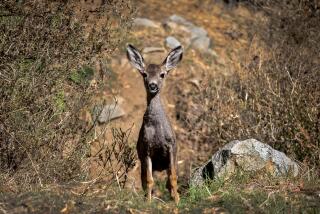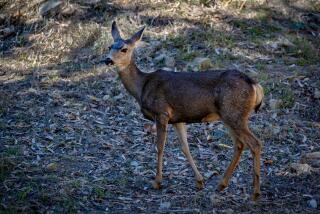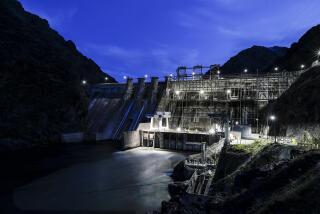It’s not just ground squirrels dodging bullets in Idaho
- Share via
BOISE, IDAHO — On Idaho’s high desert, prairie falcons and eagles soar above the Snake River Birds of Prey National Conservation Area, hunting ground squirrels that pop their heads by the thousands above the warming earth.
Also watching for the rodents, known as “whistle pigs” for their shrieks: bands of ATV-riding, gun-toting sport shooters, some of whom also take potshots at the federally protected birds or grazing cattle -- all on 68,000 acres of the 490,000-acre federal preserve declared off-limits to rifles and pistols.
The federal Bureau of Land Management is considering forbidding the weapons on another 41,000 acres of the conservation area by this summer, but not because of bird or cow mortality. Shooters’ bullets are whizzing around Idaho Army National Guard troops, who say slugs bounce off their tanks on a regular basis.
“There’s a segment of the shooting community that will shoot at anything that moves,” said John Sullivan, the area’s manager.
It’s another weird tale of the developing West, where greater numbers of armed weekend warriors, falcons and golden eagles, Black Angus cattle, Bradley tanks and even the lowly squirrel compete for this ancient volcano-studded expanse of grass and sage south of Idaho’s capital.
“What’s happened over time, as the population has grown, we get more and more people out there,” said Lt. Col. Stephanie Dowling, a Guard spokeswoman. “Not everybody uses good safety precautions.”
Shotguns, with a shorter range, are still allowed. A citation carries a penalty of up to a $1,000 fine and a year in prison.
But Sullivan’s agency has just two law enforcement agents to patrol 4 million acres of desert near Boise, including the Birds of Prey area that’s home to the largest concentration of nesting raptors in North America. The agents apprehend fewer than 10 people annually shooting rifles or pistols in restricted areas, which are clearly marked by bullet-riddled signs.
Still, it used to be worse before the rifle-and-pistol ban in 1996. “It was like World War III on the weekends out there,” Sullivan said.
“When it gets crowded, people don’t always use the best judgment,” said Mike Rainey, manager of Buckhorn Gun and Pawn in Boise. “There’s lots of squirrels, and it’s a pretty hardy little rodent.”
Although Sullivan says dozens of birds are probably shot annually, Boise State University researchers say long-term negative effects are undocumented.
“The prairie falcons are probably stable,” said Mark Fuller, director of the Raptor Research Center at BSU.
Tom Nicholson, who runs 3,000 pairs of Angus cows and calves on grazing leases inside the conservation area, said he lost several animals every spring to shooters.
“They take a little lunch and beer,” Nicholson said. “It’s the weekend, they’re tired of working and they want to shake off the winter dust.”
He’s remarkably forgiving, especially for a guy out more than $1,000 every time a cow dies.
“It’s public land,” Nicholson said. “They have as much right to be on the range as we do.”
In July, the BLM plans to issue new rules that could broaden the size of the conservation area where rifles and pistols are banned, Sullivan said.
More to Read
Sign up for Essential California
The most important California stories and recommendations in your inbox every morning.
You may occasionally receive promotional content from the Los Angeles Times.










